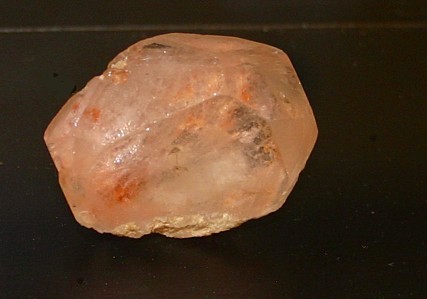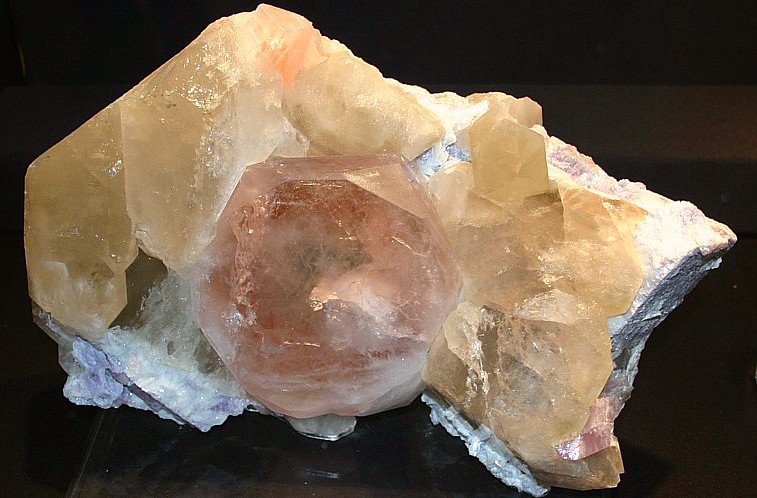|
.
Morganite (Beryl) Mineral Facts:
Chemical Formula: Be2Al2(SiO3)6
A trace of water is included.
Colors:
Morganite is the
Pink to peach variety of beryl, and is colored by small amounts of
manganese. It normally also contains significant Cesium as a trace
element. It normally comes out of the ground in a peach or salmon color.
The peach colors fade on prolonged exposure to sunlight to tones of
pink. The intensity of the pink is proportional to the intensity of the
original peach color. Its streak is white.
Hardness:
7.5 to 8.0
Hardness varies somewhat depending
on formation and impurities.
Density: 2.6
to 2.8
Cleavage:
Beryl's
cleavage is very imperfect but there is frequently a parting parallel to
the base.
Crystallography: Hexagonal
Strong
prismatic habit. The
usual form is in sharp and,
in some cases, very large columnar crystals with a distinct hexagonal
habit.
Morganite is normally found in short stubby crystals flattened on the
"C" axis.
Crystals are occasionally vertically striated and grooved. Forms usually
present consist only of prism of first order and base. Crystals can be
of considerable size with rough faces.
Luster:.
Beryl has a glassy
luster. It is transparent or translucent. Morganite is the name
given to the pale pink form of this mineral. Used as a gem or as a
collectors stone.
Optics:
(Refractive Index):
w= 1.5740, e= 1.5690
Pleochroism
is noticeable in green (emerald) and blue (aquamarine) crystals.
|
 |
|
Composition,
Structure and Associated Minerals:
Beryl is a frequent constituent
of coarse-grained granites. It is important as a gem material, and is
particularly interesting because of the many physical investigations that
have been made with the aid of its crystals. Although the mineral is
essentially a beryllium alumino-metasilicate, it usually contains also a
little Fe2O3
and MgO, in many
cases small quantities of the alkalies, and in some
cases also cesium. The mineral occurs as an accessory constituent in
pegmatites and granites, in crystalline schists, especially mica schists and
gneisses, in ore veins and sometimes in clay slates and bituminous
limestones. Morganite is often associated with
quartz,
pink tourmaline, lepidolite and
albite.
Uses. The impure varieties are used
as an important ore of the Space-age metal Beryllium. The transparent
varieties are utilized as gems, under the following names:
Emerald is a deep green variety, the color is
due to Chromium or Vanadium.
Aquamarine, a blue-green variety, colored by
iron,
Golden beryl, a golden yellow-colored variety,
Morganite, a pink, high cesium variety colored
by manganese,
Goshenite or White beryl, a colorless variety.
Identification and Diagnostics
Beryl
whitens and fuses
with difficulty at 5-5.5 to an enamel. Yields a little water on intense
ignition. Insoluble in acids. Recognized usually by its hexagonal crystals,
its hardness, color, etc. Beryl is distinguished from apatite, which it much
resembles, by its greater hardness.
Occurrence,
Localities and Origins:
Attractive morganite specimens
are very popular with mineral collectors, and transparent crystals are used as a gem
stone. The gem was first described by George Kunz, who named it
after J. P. Morgan, a famous financier and mineral collector. The deposits
that yielded these first specimens were from San Diego County in California.
This area has continued to yield a number of excellent gems and specimens
over the years. In modern times, Brazil has yielded the largest amounts of
this gem mineral. Morganite has also been mined in
Madagascar, Mozambique, Namibia, Afghanistan, and
Russia. Although it has been mined in a
number of locations, most of these places have yielded very limited amounts
and fine specimens and gemstones remain relatively rare.
Return to the
Mineral Collectors Information Page |
 |
|






